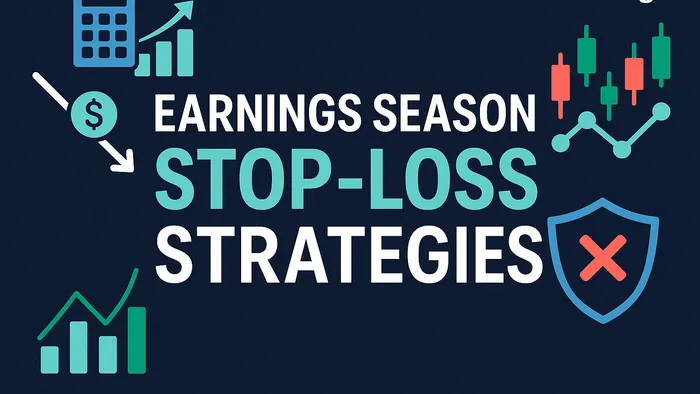Learn how to navigate earnings season with effective stop-loss adjustments and risk management strategies to protect your investments.
Navigating earnings season can be tricky due to unpredictable stock price swings. Traders often face challenges with stop-loss orders during this period, as earnings announcements can trigger sharp price movements. Here's what you need to know:
- Earnings Volatility: Stocks often experience pre-announcement price build-ups, post-announcement gaps, and intraday reversals. These patterns make traditional stop-loss strategies less effective.
- Stop-Loss Adjustments: Strategies include widening stop-loss levels (e.g., from 5% to 10%), reducing position sizes, or using tools like Average True Range (ATR) for volatility-based stops.
- Alternative Risk Management: Options like protective puts can cap losses without relying on stop-loss orders.
- Key Tools: LuxAlgo provides indicators on TradingView that surface momentum shifts and support/resistance levels, helping traders refine their strategies.
The key takeaway? Balancing risk management with earnings-driven volatility requires a flexible, data-driven approach.
Smart Take Profit & Stop Loss Strategies for Daily Trading – Powered by AI
1. Price Movement Patterns During Earnings
Earnings announcements often lead to distinct volatility patterns, adding complexity to risk management strategies.
One typical pattern is the pre-earnings buildup. In the days leading up to an announcement, implied volatility often rises, and stocks may see sharper price swings. Traders positioning themselves for the news can sometimes trigger stop-loss orders prematurely, even before a favorable price move occurs.
After earnings, price reactions tend to unfold in phases. Initially, there’s usually a sharp response as trading algorithms and investors react to the announcement. This is often followed by a brief consolidation period as the market processes the full report and any accompanying commentary. A secondary price move may follow as investors reassess the company’s longer-term outlook. These phases can vary depending on the industry and the size of the company, influencing the effectiveness of stop-loss strategies differently.
The scale of these price shifts often depends on sector and market capitalization. For instance, tech stocks typically experience larger swings after earnings announcements, while more stable sectors see milder fluctuations. Smaller companies, in particular, tend to exhibit more dramatic volatility during earnings season.
Gap patterns are another critical factor. After-hours earnings releases can cause stocks to open at prices significantly different from the previous session’s close. This can make traditional stop-loss orders less effective, especially if prices open beyond expected support levels.
Intraday reversals also pose challenges. A stock might initially rally on strong revenue results but then reverse sharply if forward guidance is more cautious. These rapid swings highlight the limitations of fixed stop-loss placements.
Trading volume spikes are common during earnings announcements, with volumes often exceeding normal levels. While the increased liquidity can help with order execution, it also contributes to heightened volatility.
Tools like LuxAlgo's Oscillator Matrix can be especially helpful in these scenarios. By identifying momentum shifts and divergences in real time, it provides insights into when the initial earnings reaction might be losing momentum. This enables traders to adjust stop-loss levels more effectively, aligning with a broader risk management strategy.
Finally, the options market plays a role in price behavior during earnings. Increased activity in options can lead to hedging by market participants, which can further amplify stock price movements.
Recognizing these patterns is key for traders to understand when traditional stop-loss strategies may fall short, emphasizing the need for more adaptive, volatility-sensitive approaches.
2. Stop-Loss Adjustments for High Volatility Periods
Adjusting stop-loss levels during earnings season requires a thoughtful approach to balance capital protection with the realities of unpredictable price swings. Traditional stop-loss strategies often fall short when faced with the sharp movements caused by earnings announcements. By fine-tuning stop-loss settings, traders can better manage risk while taking advantage of earnings-driven price action.
One common adjustment involves increasing the stop-loss distance. For example, instead of sticking to a typical 5% stop-loss, you might expand it to 10–12%. This means that a $100 stock could drop to $88–$90 without triggering a stop, allowing for normal earnings-related volatility without prematurely exiting the position. Research shows that after-hours earnings announcements frequently lead to immediate price jumps, underscoring why wider stop-loss levels can be practical during these windows[1].
Position sizing is another key consideration. If you decide to widen your stop from 5% to 10%, it’s wise to reduce your position size to maintain consistent dollar risk. For instance, if you originally held 1,000 shares with a $5 stop, you might scale back to 500 shares with a $10 stop, keeping your total risk in check.
Some traders take a different route by temporarily suspending stop-loss orders. This strategy involves removing automatic stops 24–48 hours before an earnings release and relying on mental stops or active monitoring instead. The goal is to avoid being stopped out by algorithmic trading or exaggerated price gaps during thinly traded pre-market or after-hours sessions.
Another dynamic approach is using volatility-based stops, such as those calculated with the Average True Range (ATR). ATR-based stops automatically adjust to reflect recent price volatility. During earnings season, these stops naturally widen as volatility increases and tighten again as conditions stabilize. Tools from LuxAlgo’s Price Action Concepts can help identify volatility patterns and refine stop-loss settings based on real-time market structure.
A phased adjustment strategy often works well for earnings trades. Before the announcement, traders might widen or temporarily remove stops to account for expected volatility. Once the initial price reaction settles — usually within 24–48 hours — stops can be tightened again, using updated support and resistance levels to guide placement. This two-step process helps manage risk while adapting to new market conditions.
For added protection, options can play a role. Buying protective puts allows traders to cap downside risk without relying on stop-loss orders, which can be prone to execution issues during rapid price movements. While this approach comes with added costs, it provides a safety net against short-term volatility spikes.
Historical volatility trends should also shape your stop-loss strategy. During periods of rising volatility, companies that miss earnings expectations tend to underperform by a larger margin compared to more stable periods[2]. This highlights the importance of adopting more aggressive stop-loss adjustments when market-wide volatility is elevated, rather than focusing solely on individual earnings events.
After the earnings announcement, it’s important to reset stop-loss levels based on new support levels. Signs such as declining implied volatility and normalized trading volumes indicate that the market is stabilizing, making it a good time to return to standard stop-loss settings.
Timing these adjustments is critical. Even after earnings are released, a meaningful share of companies can experience elevated implied volatility for days. Monitoring volatility indicators can help you decide when to revert to your usual stop-loss strategy.
Avoid the pitfalls of setting stops too tightly or neglecting adjustments altogether during earnings season. A systematic approach — using historical data, adjusting stop-loss distances, and leveraging real-time insights — can help you navigate these volatile periods while protecting your capital and maintaining control over your positions.
Pros and Cons
Building on the analysis of earnings patterns and stop-loss adjustments, let's dive into the strengths and weaknesses of each approach. Understanding these trade-offs can help shape your strategy when navigating volatile markets.
Earnings reports offer a snapshot of a company's financial health, often sparking significant stock price movements. Key metrics like revenue, earnings per share, and management guidance provide solid data points to base trading decisions on, moving beyond speculation or reliance on technical indicators. At the same time, effects such as post‑earnings announcement drift (PEAD) can introduce additional complexity in the days after results.
However, these reports can also lead to unexpected price swings. For instance, a stock might drop even after exceeding analyst expectations. This counterintuitive behavior often stems from investor sentiment, future guidance concerns, or broader market trends. On top of that, sector-wide volatility can amplify these reactions, making price predictions challenging even when the fundamentals look solid.
Stop-loss adjustments, on the other hand, are a go-to method for managing risk during earnings season. They help limit losses during volatile swings and can be automated for flexibility. But there’s a downside: short-term market fluctuations might trigger these orders prematurely, leading to exits from positions that could have rebounded. This not only reduces potential profits but also increases transaction costs due to slippage[3].
Here’s a quick comparison of the pros and cons:
| Approach | Advantages | Disadvantages |
|---|---|---|
| Earnings Report Analysis | Provides immediate insights, supports data-driven decisions, highlights sector-wide impacts | Prone to unpredictable reactions, sector volatility, and limited price correlation |
| Stop-Loss Adjustments | Protects capital, enables automated risk management, adapts to market volatility | Risk of premature exits, missed recoveries, and execution slippage during rapid moves |
| Combined Strategy | Balances risk and reward, supports informed decisions, adapts to changing conditions | Requires more analysis, risk of overtrading, adds complexity |
These comparisons highlight the importance of a well-rounded approach when managing risk during volatile earnings periods. Data shows that companies missing earnings estimates tend to face harsher market reactions than those beating them, especially during periods of heightened volatility[2].
For traders using LuxAlgo, these challenges become more manageable. LuxAlgo’s indicators and AI Backtesting Assistant allow for a more refined strategy. Its real-time volatility analysis helps pinpoint optimal stop-loss levels based on historical earnings data, while signal algorithms provide insights into whether earnings-driven price movements will stabilize or continue trending.
Ultimately, neither approach is flawless on its own. Earnings report analysis offers valuable insights but comes with the risk of unpredictable market reactions. Meanwhile, stop-loss adjustments provide a safety net but can limit profit potential or lead to unnecessary trades. Many traders find success by blending both strategies, striking a balance between seizing opportunities and managing risk effectively.
Conclusion
Navigating earnings season successfully means finding the right balance between solid fundamental analysis and adaptable risk management. Earnings reports often lead to sharp price swings, which can make traditional stop-loss strategies less effective. Savvy traders address this by widening stop-loss levels and incorporating a variety of data points into their strategies.
One key takeaway is that neither earnings-focused trading nor stop-loss adjustments work well on their own. Rigid stop-loss levels, for instance, can lead to premature exits during the intense volatility that typically follows earnings announcements.
Fortunately, modern trading platforms offer resources to tackle these challenges. LuxAlgo’s AI Backtesting Assistant and Signals & Overlays toolkit provide real-time insights to help traders refine stop-loss placements during earnings-driven volatility. These resources help bridge the gap between raw data and actionable decisions. For setup and capabilities, see the AI Backtesting docs.
By leveraging these capabilities, traders can combine fundamental analysis with real-time technical insights. For instance, LuxAlgo's Price Action Concepts toolkit identifies critical support and resistance levels automatically, including dynamic S/R. This allows traders to set smarter stop-loss levels based on actual market behavior rather than relying on fixed percentage rules.
With the right approach, traders can take advantage of earnings volatility instead of being caught off guard by it. LuxAlgo's screening and backtesting features help pinpoint stocks that are likely to sustain meaningful moves after earnings, rather than just experiencing temporary spikes.
FAQs
How can traders adjust stop-loss levels during earnings season to manage risk while staying positioned for potential gains?
During earnings season, managing risk becomes especially important due to the heightened market volatility. One way traders can navigate this is by adjusting their stop-loss levels. For instance, tightening stop-losses before an earnings report can help protect any existing gains from sudden, unexpected price movements. On the flip side, after the report is released, it might make sense to loosen stop-loss levels slightly. This adjustment can help account for the typical post-earnings fluctuations and reduce the chances of being stopped out too early.
Using technical indicators and analyzing how a stock has reacted to past earnings reports can also guide these adjustments. By tailoring stop-loss levels to the current market environment, traders can manage their risk effectively while still keeping the door open for potential gains. It's all about finding that balance between caution and opportunity.
How can LuxAlgo help improve stop-loss strategies during volatile periods like earnings reports?
LuxAlgo provides features designed to help traders fine-tune their stop-loss strategies, especially during high-volatility situations like earnings announcements. With indicators such as statistical trailing stops, these approaches automatically adjust stop levels to match sudden price swings, minimizing the chances of exiting trades too early.
This dynamic approach helps traders manage risk more effectively and safeguard their capital, even when market conditions become unpredictable.
Why are traditional stop-loss strategies less reliable during earnings season, and what can traders do instead?
During earnings season, the market tends to be more volatile, making traditional stop-loss strategies less effective. Earnings reports can lead to sudden price jumps or drops, which might trigger stop-loss orders too early, causing traders to exit positions unnecessarily or miss potential gains.
To handle this, traders could explore options strategies like straddles and strangles. These strategies are built to take advantage of large price swings while offering a way to manage risk without depending entirely on stop-loss orders. Another approach is to adjust stop-loss levels to align with the expected volatility during earnings, which can help minimize the risk of being stopped out at the wrong time.
References
LuxAlgo Resources
- Oscillator Matrix — Reversal Signals (Docs)
- Liquidation Levels (Library)
- Statistical Trailing Stop (Library)
- Algorithmic Trading (Blog)
- SCE Convergence (Library)
- Oscillator Matrix (Library)
- S&O Backtester — Take Profit/Stop Loss (Docs)
- Inversion Fair Value Gaps (Library)
- Dynamic Support & Resistance (Library)
- Option Drops — Buy/Sell-Side Volume (Library)
- Risk Management Tool (Library)
- AI Backtesting Assistant (Platform)
- AI Backtesting Assistant — Introduction (Docs)
- S&O Backtester (Library)
- AI Backtesting Assistant — Deep Dive (Blog)
External Resources
- TradingView — Average True Range (ATR)
- Investopedia — Implied Volatility (IV)
- UC San Diego — Earnings News and Price Jumps
- Standard Chartered — Impact of Volatility on Earnings
- Investopedia — Protective Put
- Investopedia — Straddles vs. Strangles
- LSEG — Predicting Post‑Earnings Drift
- CFA Institute — PEAD and Market Efficiency








